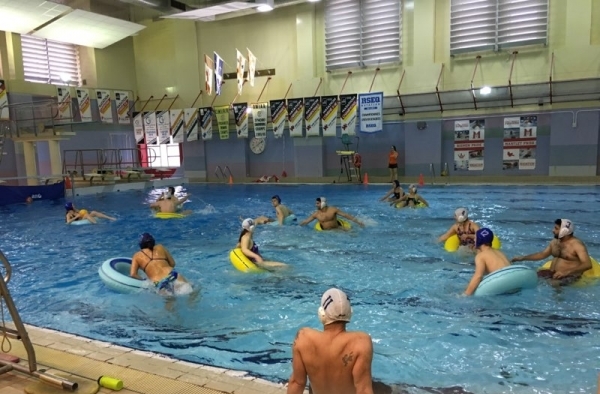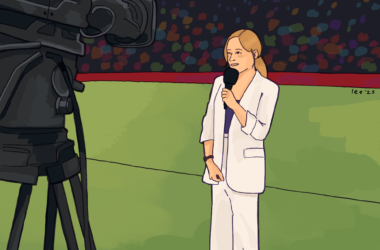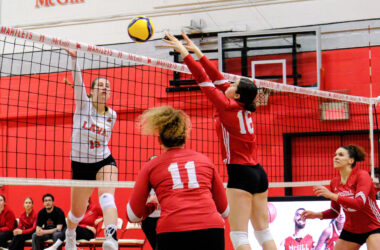Given that over 40,000 students attend McGill every year, it’s not surprising that many were athletes before coming to McGill. For some, sports were not only a passion growing up, but a way to connect with peers. While McGill has a variety of varsity and club teams, not every student has the skill or time to play at such a competitive level. Fortunately, the intramural program offers an accessible option for McGill students to remain involved in sports.
“[Intramurals are] an opportunity for McGill students, [staff, and alumni] to participate in organized sport [in a] recreational setting,” Perry Karnofsky, Manager of Campus Recreation, explained to The McGill Tribune.
The McGill intramural program features an average of 10 sports every semester, with leagues ranging from basketball to ultimate frisbee. Every semester, approximately 3,500 members of the McGill community participate on over 300 teams. Seasons generally start at the beginning of the semester, and teams register for different divisions based on experience level and competitiveness.
For many students, the intramural program becomes an integral social component of their time at McGill: It’s an outlet for them to meet other McGill students outside of their classes, as well as strengthen the friendships they already have.
U3 Engineering student Athar Ejaz highlights intramural sports as a unique opportunity to expand his social circle. Ejaz is the league coordinator for inner tube water polo and ultimate frisbee and a member of multiple teams.
“[Intramurals bring] together thousands of players,” Ejaz said. “These are people [who] you would see in your classes, or see on the street, but never say ‘hi’ to. But then after a couple times seeing them [at intramural games…] outside of the intramural context you might [reach out to them].”
For Kirk Wright, U3 Arts, playing intramural sports proved to be an invaluable method to strengthen relationships with existing friends. Wright—who has played ultimate frisbee, ice hockey, and inner tube water polo—began his intramural career on a basketball team that formed in his first-year residence. The team has maintained the same nucleus of players throughout Wright’s four years. He cites his time with the team as one of his most valuable intramural experiences
“[We went] from losing a game by 100 points in our first year to now, [where] we just made the playoffs this season,” Wright said. “It’s definitely been a journey [….] We’re not necessarily varsity athletes who get to compete at a high level, but it is fun to still have that experience and grow with people and develop.”
There are other benefits to participating in an intramural sport beyond the social aspect. The heavy course load at McGill can make it difficult to live an active lifestyle, but intramurals give students a reason to move from the library to the court, field, or pool.
“[Students] tend to get tunnel vision [and think] academics are the only thing that matters,” Ejaz said. “It is the thing that matters most, but a lot of people don’t realize that if they have a more balanced lifestyle, they’d have a better time.”
Intramural sports provide a fun release for overworked McGill students. Natalya Dreszer, U3 Environment, relied on intramurals throughout her undergraduate degree to elevate her mood, particularly during the dreary winter months.
“[Intramurals helped me] to get out of the house, [and it was nice] going and having a laugh, especially with inner tube water polo,” Dreszer said. “I can’t say enough good things about [it]. When else are you getting into your swimsuit in winter and jumping in the water?”
As the intramural program is open to alumni, some students continue to involve themselves after they graduate. Ali Sobhi, BComm ‘09, played on a variety of intramural teams throughout his undergraduate degree, although soccer was his main sport. Sobhi remains involved with intramurals at McGill, because of the community they foster.
“[Your teammates] become your [friends], and then you get to know them, so you just keep playing [with them],” Sobhi said. “It’s [more fun] to play with people you know.”
Many intramural competitors get their introduction to McGill’s program via word of mouth, generally through friends who are already involved. This informal promotion system can exclude students who might not have the right connections. As a partial solution, there are free agent meetings and Facebook groups organized for most sports at the beginning of each semester, offering an alternative avenue to find a team. Still, despite the program’s best efforts, Karnofsky acknowledges that outreach is an area that needs work.
“When [students are] coming to Montreal in August [they] get bombarded with information, and registering for an intramural sport is probably somewhere on the back-burner,” Karnofsky said. “We have some work to do, to kind of just plant the seed, whether it’s with the floor fellows, or with some of the student leaders to present [to new students] that this option exists.”
And, despite its widespread success, many students wish that intramurals were able to offer more: Dreszer expressed frustration with its capacity, caused by what she felt was a lack of resources.
“I wish that there was more time for intramural sports, [and] that there was more space for it,” Dreszer said. “I know people haven’t been able to get on teams because there’s not enough room. And I wish that there [were] more drop-in times, and more support for teams.”
While some are frustrated by perceived limitations, the intramural program is forced to compete with clubs, teams, and even departments for access to facilities. Karnofsky stressed that the shared facilities place boundaries on what sports and game times are available for selection.
“One of the challenges [we face is that] we share the facility with the Department of Physical Education, and the varsity program,” Karnofsky said. “In terms of priority, it’s education first, [then] varsity with all their games and practices, and we get what’s left over.”
Despite these challenging conditions, intramurals have become a regular weekly activity for many students. While sports may not be for everyone, the intramural community has the potential to broaden McGill students’ social horizons. In discussing his overall experience at McGill, Wright explained that the program was an integral part of his time at university.
“The McGill experience is a nebulous concept, because at such a big university there’s something for everyone,” Wright said. “Intramurals provide a really safe, fun, affordable way to get involved in sports [.…] It’s an underutilized outlet that people don’t really think of when they talk about their McGill experience, and how to build a good social circle, and stay active.”








